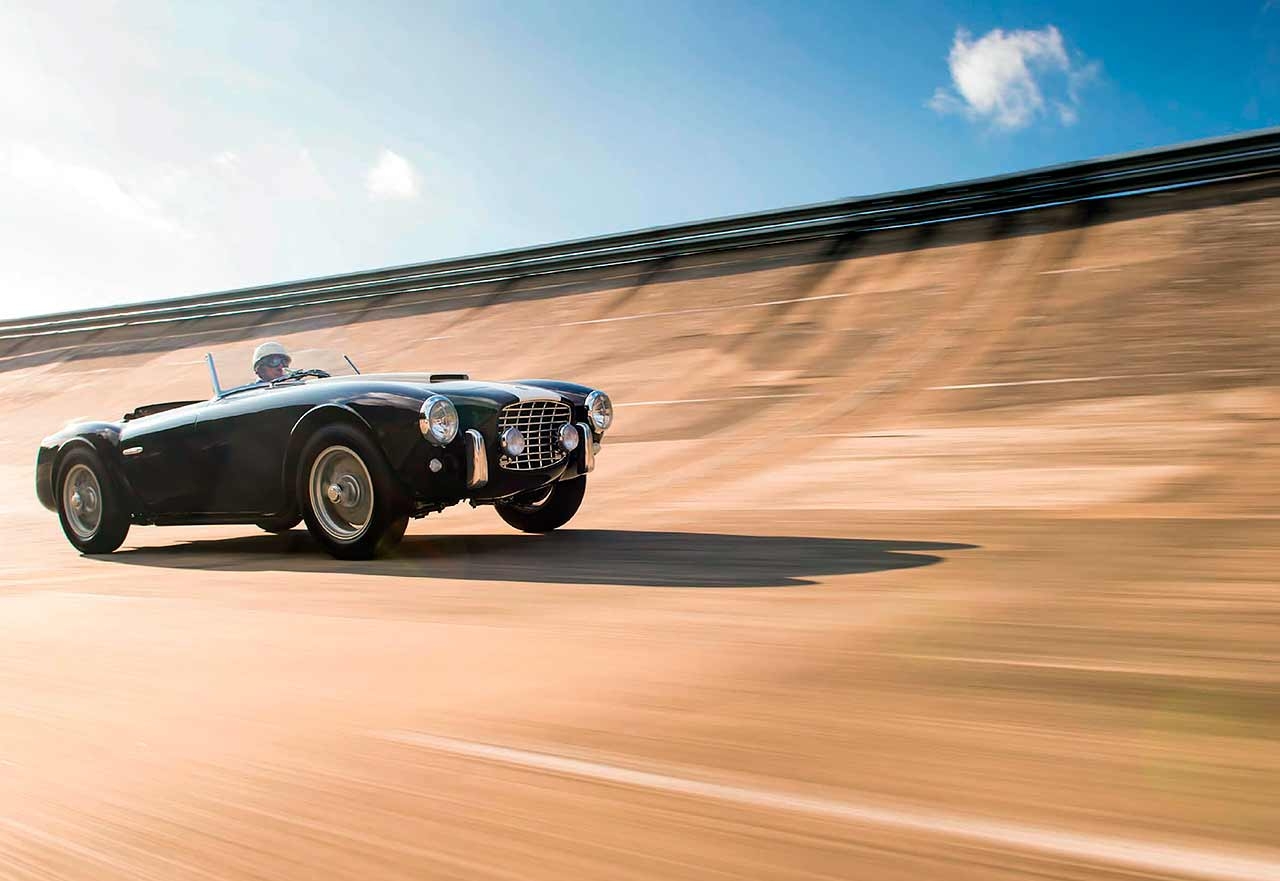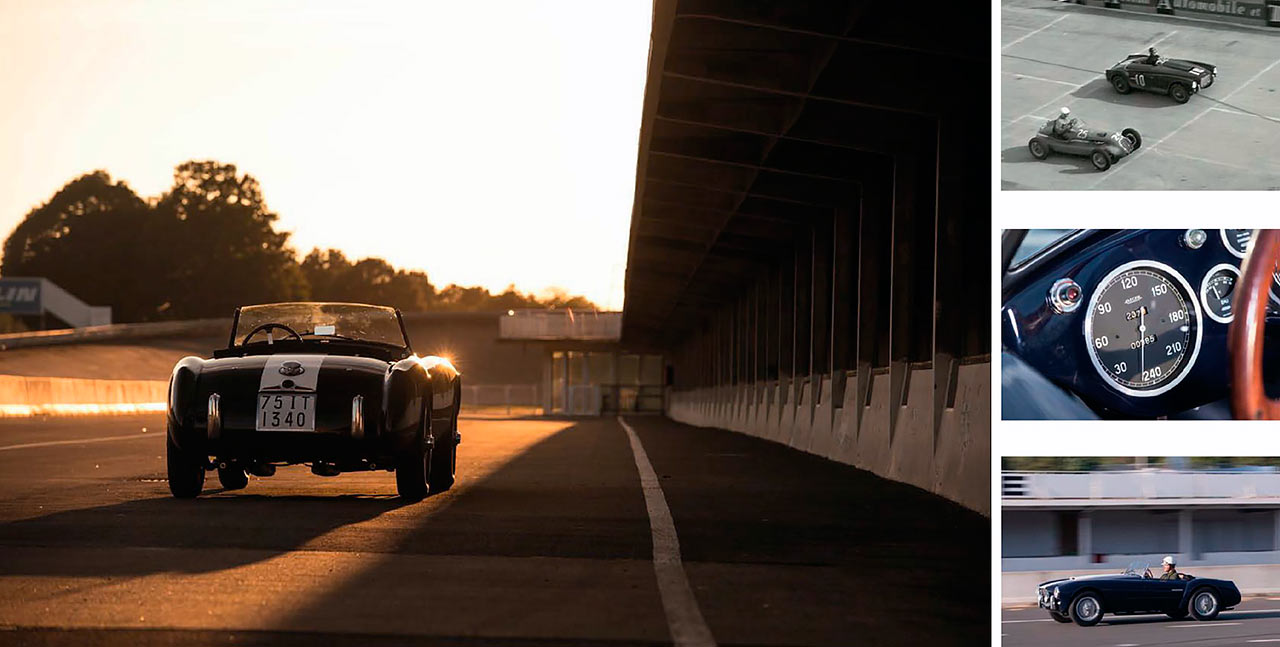
Siata back on track. From the fairways of Pebble Beach to the banking of Montlhéry. Rare Siata 208S Motto Spider returns to its natural habitat. ‘Returning to a Montlhery full of atmosphere makes the spine tingle’ So says James Elliott as he takes a super-rare example of the Otto Vu-engined Siata 208 to the French circuit where it competed in period. Photography Dirk De Jager.
style=”flat” size=”4″]At Montlhéry you don’t so much find a line as your limit. It may not look too dramatic from ground level, but barely a third of the way up the banking it starts to feel as if the car will topple over. At the slower speeds at which you have to follow a camera car it is totally unnerving – the balance is messed with, like trying to corner a motorcycle with a pillion passenger who refuses to lean with you.

Siata 208S Motto Spider track test
Finally, after a couple of laps the photographer pulls over into that historic pitlane. Now you can open up, rapidly gather speed and feel the little roadster naturally, gradually drift up the uneven, no, outright bumpy banking. It does take a while but eventually the pilot is comfortable and confident enough to put aside the instinct to lean, to sit upright in the car at what feels like parallel to the ground and perpendicular to the banking. It is a surreal sensation emotionally, flipping from a fear that if you go any quicker you will fall off, to being at a speed and a height at which you worry that if you slow even a fraction you will meet the same fate.
Seventeen years younger than its 2.75-mile Surrey inspiration, the French speedbowl is a similar distance south of its respective capital – although getting there nowadays through a city that encroaches ever further makes it feel more part of the suburbs than separate from Paris.
The banked section of the circuit is considerably more compact than the Weybridge track, at barely over 1.5 miles, and was followed after a year – in 1925 – by the addition of the road circuit. The venue hosted the French Grand Prix that July.
Just as Brooklands did, Linas-Montlhéry blossomed in the inter-war era with constant use for competition and record-breaking, but it was somewhat surpassed in the post-WW2 years and its use became sporadic. This was always a circuit with bite, but a series of high-powered, high-profile, high-speed accidents in the 1960s put paid to it as a location for modern racing.
Even in an older, slower car than those that helped to write the circuit’s death warrant, even with the track to yourself, it is easy to understand how and why. And then to admire the bravery – or foolhardiness – of those who flocked there in period. Gentlemen and racers immortalised in sepia-tinged photos, jovially chatting on the grid, compulsory cigarettes in hand, a puddingbasin helmet and extra-thick jumper in winter being the only safety precautions.
Among this happy, carefree and privileged band was a Parisian playboy called Jean Terrail. From a noted family of French hoteliers and restaurateurs, his mount was a Siata 208S Motto. There is no documentation to confirm it, but it is fair to assume that he was the first owner of the little Italian sports car based on the fact that he raced it at Montlhéry five times over three years. The Siata’s extraordinary blend of passiveaggressive functionality and svelte beauty is unnerving but alluring.
More than that, it is packing a jewel of a V8 – the famous 2-litre Otto Vu unit from Fiat – plus a five speed ’box. All of this makes it a super-rare car, fewer than 30 examples of the 208S are known to survive from the 37 built, and as far a cry as is possible from the company’s origins.
Società Italiana Auto Trasformazione Accessori was founded by Giorgio Ambrosini in Turin in 1926. As the name suggests, like so many Italian outfits that laid the foundations for the etceterini industry, the firm started off tuning and supplying hot parts for the countless Fiats rolling off the nearby production line. It did this more successfully than most and, post-war, Ambrosini’s son Renato brought the name to the attention of the world via his racing exploits in Siata-fettled small-capacity cars.
Fiat was impressed and made Siata instrumental in the early-’50s Otto Vu project, which was based around a 1996cc short-stroke all-alloy V8. When the Turin giant refocused on fourcylinder models after just 114 Otto Vus had been completed, Siata inherited the leftover engines.
These were incorporated into ex-Porsche and Cisitalia man Rudolf Hraska’s 208S, a sophisticated and beautiful-handling car with five-speed ’box and independent suspension. Farina built four coupés, Balbo another nine and Bertone one plus a pair of Michelotti-styled spider prototypes – Rocco Motto’s boutique carrozzeria fabricating the ‘production’ version of the open body. LA-based Italophile Ernie McAfee snapped up almost all the available cars. Almost.
In a history that ended in the ignominy of the Spring – imagine a Wolseley ADO16 convertible, drawn by a six year old holding a crayon like a dagger – the 208 is Siata’s zenith. Even Steve McQueen had one, referring to it as his “little Ferrari” and entering it for the Palm Springs Road Races in 1958. Built with the 2-litre racing class in mind, the 70º Tipo 104 engine was housed in a tubular Siata designed and built chassis, with all-round independent suspension by coils and telescopic dampers. Generating 115bhp at 6000rpm, it had a top speed of around 120mph and was an impressive formula, as this car bears out.
In fact, this very example has twice previously appeared in C&SC (Mystery car April 1990, plus Lost & found November 1997) but you would be forgiven for not remembering it. The radically altered front and rear bodywork it received while in the hands of its second owner, who raced it one more time in 1964, rendered the Siata unrecognisable.
It has since passed via a third French keeper and had a stay in Germany, before being bought by Belgian Marc Behaegel a few years ago. Since then, it has undergone a meticulous restoration that wound up with it gracing the 18th fairway at Pebble Beach last August, making its first public appearance since it was taken off the road in France in the 1970s. Just like our trip to Montlhéry, that beauty pageant signified the car’s life turning full circle.
In 1956, it had taken part in the Concours d’Élégance at Enghien-les-Bains and was featured widely in the press, replete with whitewall tyres and ‘presented’ by French starlet Yannick Arvel. This Siata even made the pages of Autosport in April 1955 when Terrail campaigned it on the Rallye Soleil-Cannes. Intriguingly, it was listed as a works car. For that event a hole was cut in the dashboard for a map light but its purpose remained unexplained until the recent restoration. Rather than fill it in, it was retained as part of the Siata’s history.
After so long in the doldrums, it is gratifying that the car’s impressive history is not only being revived and reinvestigated, but also added to. Behaegel is an interesting owner, with a fascination for Fiat’s 2-litre V8 in all its incarnations, – there’s also a Ghia Supersonic and Otto Vu Zagato in his collection. He explains: “I was looking at buying a Frazer Nash Le Mans Replica when I first found out about the 8V. I was sharing a 300SL in a local rally and fell in love with one. I was in business and spent all my time in the air, flying to the US maybe 20 times a year, so I read an awful lot of classic car magazines. I decided that the 8V was relatively affordable and different to what everyone else collects.
“The Siata was a progression from that. I bought it three and a half years ago. I was looking at an Osca, but a specialist told me I shouldn’t buy it. He was showing me pictures of the cars he’d sold in the past and there was a Siata, so I said I wanted to see it. The German owner was chasing a Maserati and needed the money, so the Siata was due to go to auction, even though it was midrestoration.
We stopped the work and started again from scratch in Italy and The Netherlands.” Thankfully, this matching-numbers car (chassis BS532, engine BS132) came with the now super-rare Weber 36s that are more usually found on Ferraris and which change hands for ridiculous amounts as a result. But then if you do the sums, this is as rare as virtually any contemporary from Maranello. On top of the basic survival numbers, only 17 208s are thought to still have the correct engine and chassis pairing.
A Motto Spider with race history, matching numbers and the five-speed gearbox narrows it down to fingers-of-one-hand status.
That rarity alone would give our test a sense of occasion, but the fact that the Siata has covered only a few hundred post-restoration miles and is being returned to a deserted Montlhéry full of ghostly atmosphere makes the spine tingle.
The paint glimmers in the pitlane to fully show off the delectable lines. The delicacy and shapeliness on such a small two-seater were rivalled in the 1950s only by the AC Ace and one or two others. Central to this blend of purpose and beauty is the grille, a feature the restorers toiled over to get absolutely right, and the concave nature of which perfectly softens the bluff aperture. Only the half-hearted tailfins (a sop to the jet-age or simply the American market) disrupt the curves and even they are rounded.
In the cockpit it is relatively spartan, a huge four-spoke steering wheel dominating ahead of the plain painted dash that places all the instruments ahead of the driver. It is roomy and comfortable for both occupants, though.
Fire up the Siata and the incessant thump of the pistons distinguishes this scaled-down V8 from the lazy thrum of a large-capacity unit. Don’t underestimate this little motor, though: it cleaned up in class in period, taking the Grand Touring and Special Touring titles in the ’55 Targa Florio, Elio Zagato and Ovidio Capelli coming 11th overall, plus a host of national championships.
It simply does not feel like a GT powerplant, however, and there is nothing cruising about its gait. This is all sports car – and an incredibly easy one to drive, at that. Except, that is, for the pedal placement. Despite there being plenty of room in the footwell, all three pedals are closely gathered to the right, the pendant throttle and floor-mounted brake almost overlapping and proving tricky to operate individually until you are used to them. Especially ‘novel’ is the slab of ridged metal that constitutes the accelerator.
Slip the smooth ’box into first and the Siata, this one boasting 125bhp, punches forwards impressively, confirming that it is an out-and-out sports car. As you work through the gears, raising the yowl of that taut engine and zipping through the chill air, those inconvenient pedals suddenly become a work of genius for heel and toeing.
The ridge in the throttle puts it at precisely the same height as the brake, and all the pilot need do is lean his right foot to one side for full effect. On an uneven surface that would disturb any non-Citroën it’s hard to gauge the handling, but the fluid yet sharp steering is barely troubled. Thanks to the pedals and the revs required to get it off the line being so at odds with the car’s appearance, the Siata is a difficult machine to start driving. But once you are used to it (and it doesn’t take long at all), it is a car that is even more difficult to stop driving.
All too soon the sun is dipping below the banking and our time is up. Even without such a rich provenance, this would be a fabulous vehicle, and an important and trailblazing one, too. The Siata may be a footnote in ’50s motoring history, but just for a moment consider the concept. A V8 transplanted into a small, lightweight aluminium-bodied European sports car with sublime balance, precise steering, great gearchange and independent suspension. Such a thing might just catch on in America.

The 208S at speed as the sun dips below the historic Montlhéry banking – the car earnt its spurs here in period. Inset: the Siata has previous in C&SC, having appeared in Lost & found and been a Mystery car.

Clockwise: nose melds AC with Lancia D24; car was second in class in Coupe de Vitesse in ’1955; proud crest; wonderful Otto Vu motor; four-spoke wheel dominates simple cockpit; with Yannick Arvel in ’1956.
‘THE PAINT GLIMMERS IN THE PITLANE TO FULLY SHOW OFF THE DELECTABLE LINES OF THIS SHAPELY TWO-SEATER’

Clockwise: tautly styled 208S at rest in Montlhéry pitlane; Terrail finished 11th in Coupe d’Automne in 1954; spider looks truly gorgeous in profile; dash is comprehensively stocked with Jaeger dials.






